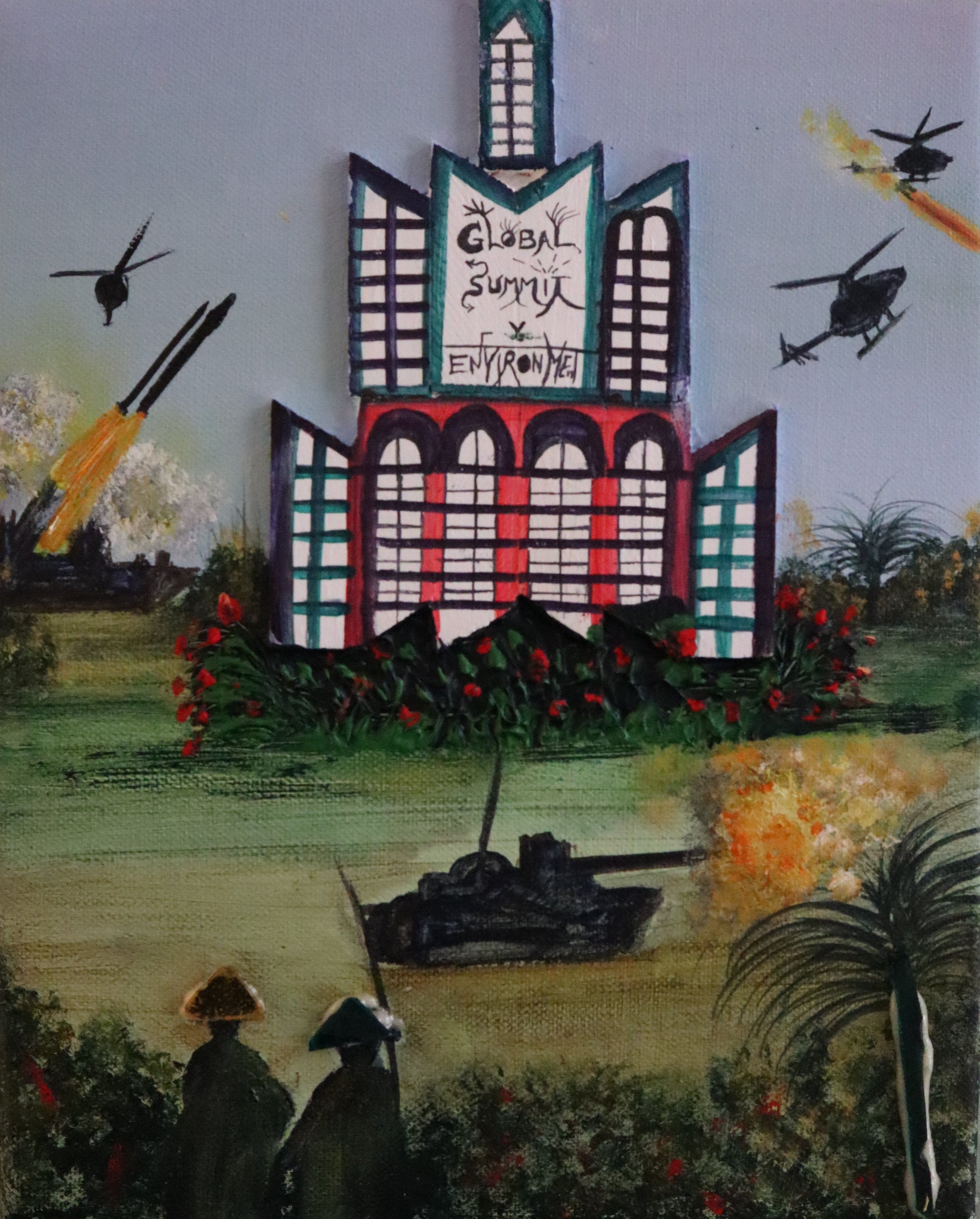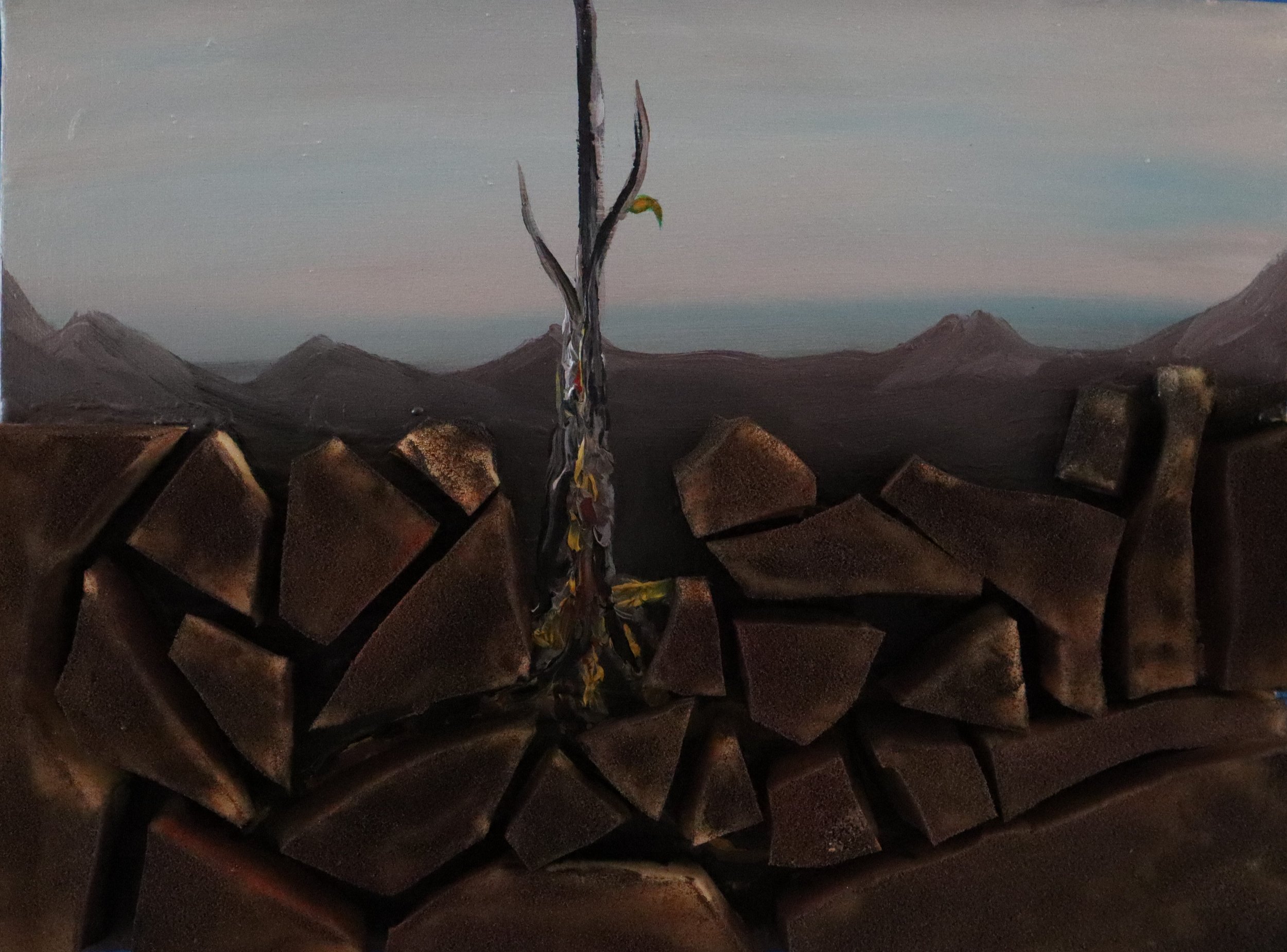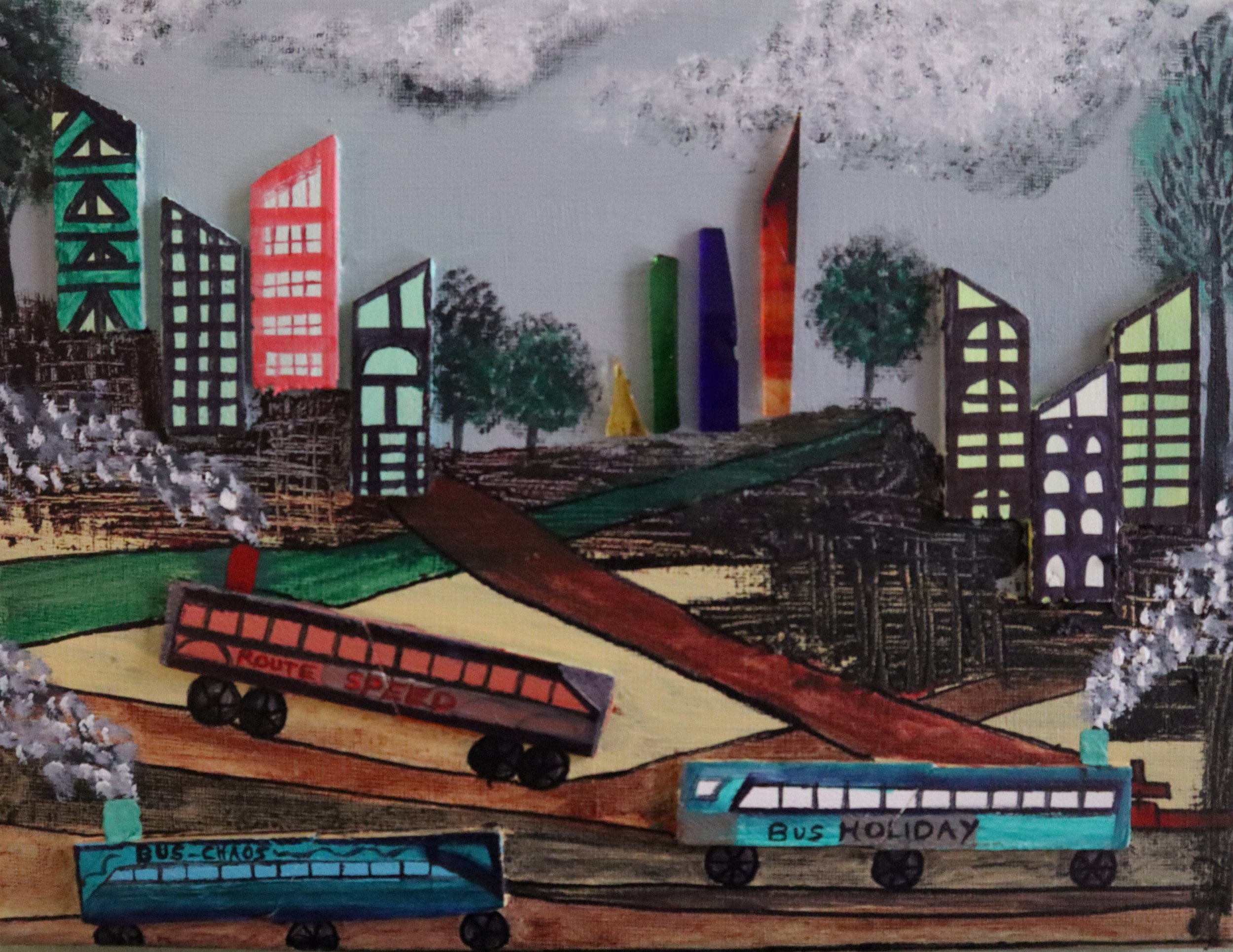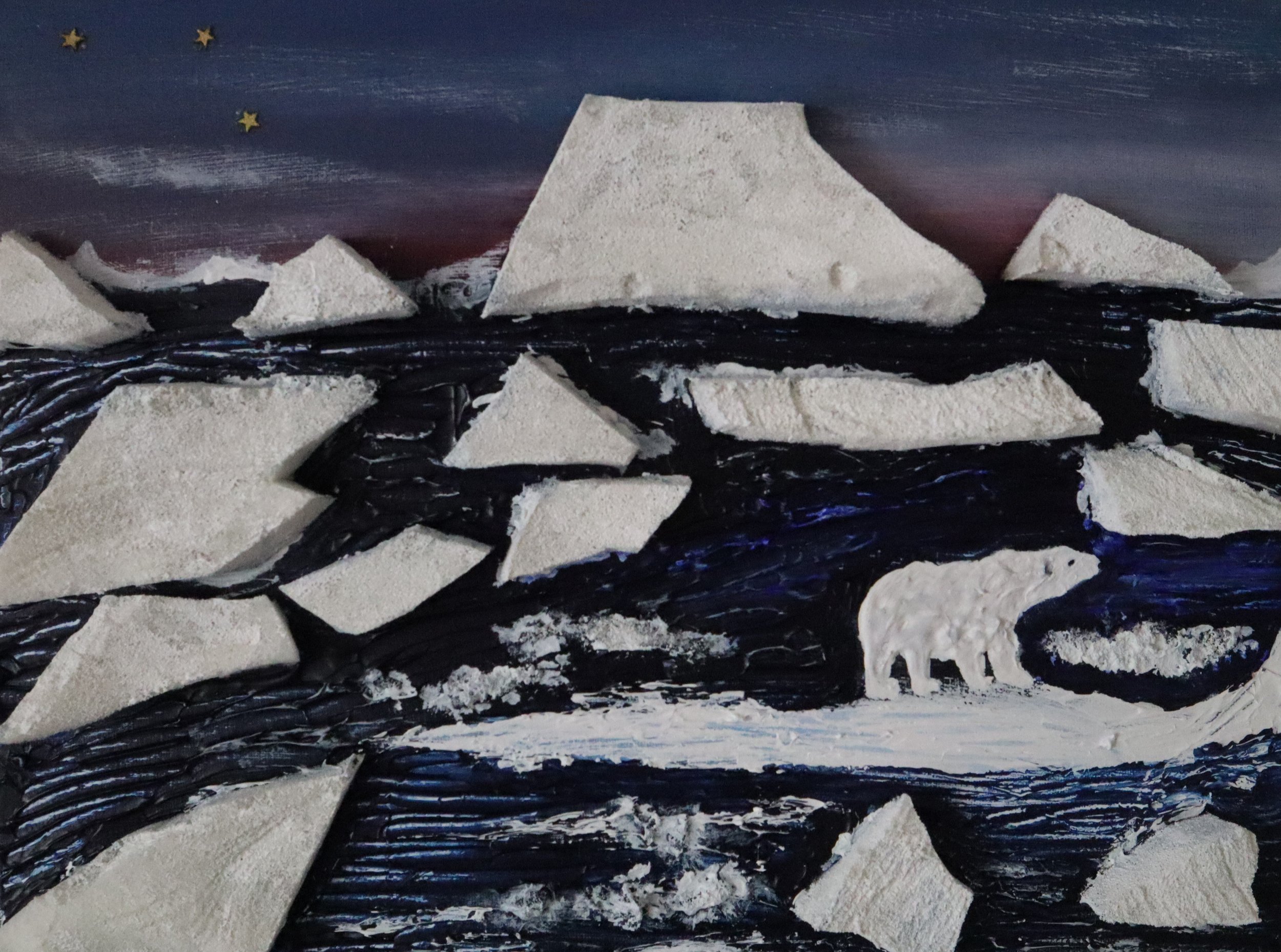Click on each image to view
The Floating City
How Peaceful Inside the Summit House!
I cannot climb those dunes anymore!
The Floating City
Medium: Acrylic – Glass – Wood – Corals – Plastic – Soda Debris Fabric
Theme: Pollution: LS (21)
*This piece sheds light on pollution that affects everyone on this planet, caused by transport, industrial fumes substances which contribute to the acidification of soil and water, fertilizers, insecticides, fungicides, herbicides and ergotoxines. It also draws our attention to the non-biodegradable, highly toxic and radioactive generated waste, which comes from various sources such as homes and businesses as well as construction and demolition sites. Also, exposure to atmospheric pollutants produces a broad spectrum of health hazards, especially for the poor, and causes millions of premature deaths.
How Peaceful Inside the Summit House!
Medium: Acrylic – Glass – Wood
Theme: Weak Reponses: LS (54)
*This work conveys a simple yet remarkable message of how weak international political responses have been. The failure of global summits on the environment makes it plain that politics are subject to manipulating information and serving special and economic interests, thus trumping the common good. The consequence is that the scene will be set for new wars, causing grave harm to the environment and to the cultural riches of people.
I cannot climb those dunes anymore!
Medium: Acrylic – Foam
Theme: Climate Change - Loss of Biodiversity: LS (35)
*This picture sums up how environmental changes have detrimental effects not only on soil, water, and air but also on biodiversity, loss of species, animals and plant groups. The damage is crowding out natural habitats and, at times, breaking them up in such a way that animal populations can no longer migrate or roam freely. As a result, some if not many species face extinction.
Click on each image to view
Title: The Weeping Tree
Medium: Acrylic – Foam
Theme: Global Inequality: LS (28)
*In this piece, we get to see how water poverty affects many especially in Africa, where large sectors of the population have no access to safe drinking water. The dramatic consequences lead to droughts which impede not only human life and agricultural production, but also terrestrial and aquatic ecosystems.
Title: The Forest on Fire
Medium: Acrylic – Ink – Silk
Theme: Global Inequality - Loss of Biodiversity: LS (38)
*This painting takes us on a virtual journey to become aware of how the ecosystems of forests possess an enormously complex biodiversity. When these forests are burned down or levelled for purposes of cultivation, within the space of a few years countless species are lost and the areas frequently become arid wastelands.
Title: The Haunted Forest
Medium: Acrylic – Wood – Plastic
Theme: Pollution – Deforestation: LS (34/23)
*This canvas portrays the loss of forests and woodlands and how they contribute to the extinction of species of mammals and birds. Another determining factor is the increase in changed uses of the soil, principally deforestation for agricultural and urban development purposes.
Click on each image to view
The Sunken Cottage
Do not die beautiful Nile!
The Red Hare
Title: The Sunken Cottage
Medium: Acrylic – Wood
Theme: Global Inequality: LS (48)
*This painting highlights how global warming leads not only to the rise in temperature of the oceans but also to its water level. This affects impoverished coastal populations who have nowhere else to go. The impact of present imbalances in water level across the globe is also seen in the premature death of many of the poor.
Title: Do not die beautiful Nile!
Medium: Acrylic – Coffee
Theme: Global Inequality: LS (51)
*This image shows how global warming caused by huge consumption on the part of some rich countries has repercussions on the poorest areas of the world, especially Africa, where a rise in temperature, together with drought, has proved devastating for farming. As a result, rivers, deltas, and natural reserves get depleted and eventually dry up.
Title: The Red Hare
Medium: Acrylic – Glass – Wood
Theme: Loss of Biodiversity: LS (41)
*This painting portrays how global warming leads to the loss of forests and woodlands, which in turn contributes to the extinction of species of mammals and birds. It also highlights how many of the world’s coral reefs are already barren or in a state of constant decline, for they shelter approximately a million species, including fish, crabs, molluscs, sponges and algae. This drastic change in biodiversity is turning the wonderworld of the seas into underwater cemeteries bereft of colour and life.
Click on each image to view
Sorry I have no time!
Only one big Fish!
Let us Take a Bus Ride
Title: Sorry I have no time!
Medium: Acrylic – Silk – Stones – Metal – Wood
Theme: Decline in the Quality of Human Life and the Breakdown of Society: LS (47)
*This canvas highlights the noise and distractions of information overload. The digital world is increasingly becoming omnipresent, thus shielding people from direct contact with the pain, the fears and the joys of others and the complexity of their personal experiences. Today’s media is becoming influential, which can stop people from learning how to live wisely, to think deeply and to love generously. Efforts need to be made to help these media become sources of new cultural progress for humanity and not a threat to our deepest riches.
Title: Only one big Fish!
Medium: Acrylic – Plastic
Theme: Global Inequality: LS (48)
*This work brings our attention to the deterioration of the environment and of society and how this affects the most vulnerable people on the planet. For example, water pollution affects many people but particularly those impoverished coastal populations. The depletion of fishing reserves hurts those small fishing communities without the means to replace those resources.
Title: Let us Take a Bus Ride
Medium: Acrylic – Glass – Wood
Theme: Decline in the Quality of Human Life: LS (44)
*This picture talks about the disproportionate and unruly growth of many cities, which have become unhealthy to live in, not only because of pollution caused by toxic emissions but also as a result of urban chaos, poor transportation, and visual pollution and noise. Many cities are huge, inefficient structures, excessively wasteful of energy and water. Neighbourhoods, even those recently built, are congested, chaotic and lacking in sufficient green space. Humans are not meant to be inundated by cement, asphalt, glass and metal, and deprived of physical contact with nature.
Click on each image to view
Searching for a New Home
Living with Courage
The Great Eruption
Title: Searching for a New Home
Medium: Acrylic – Foam – Fabric
Theme: Climate Change – Loss of Biodiversity: LS (24)
*In this piece we witness the disturbing warming of the climatic system and its effects on the carbon cycle. The melting in the polar ice caps and in high altitude plains can lead to the dangerous release of methane gas, while the decomposition of frozen organic material can further increase the emission of carbon dioxide. The consequence is the extinction of part of the planet’s biodiversity.
Title: Living with Courage
Medium: Acrylic – Glass – Wood – Plastic – Fabric
Theme: Waste – Pollution: LS (21)
*This image captures how the earth, our home, is beginning to look more and more like an immense pile of filth. Millions of tons of waste are generated from food, clinical, electronic, and industrial sources. Also, the damage caused by the export of solid waste and toxic liquids to developing countries, and by the pollution produced by companies which operate in less developed countries in ways they could never do at home, in the countries in which they raise their capital.
Title: The Great Eruption
Medium: Acrylic – Foam
Theme: Climate Change: LS (23)
*This work invites us to witness the disturbing effects of human industrial activities, which is leading to a constant rise in the sea level and an increase of extreme weather events. Some examples as such are the intensive use of fossil fuels, which is at the heart of the worldwide energy system. Also, the release of great concentration of greenhouse gases (carbon dioxide, methane, nitrogen oxides and others). The effect of this on the atmosphere is hampering the escape of heat produced by sunlight at the earth’s surface. To combat this warming, humanity is called to recognize the need for changes of lifestyle, production and consumption.














